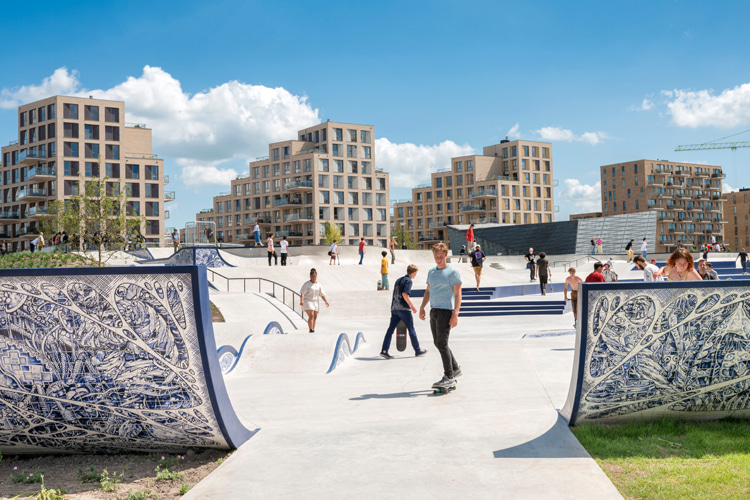Since the 1960s, skateboarding has rolled in and out of the public's consciousness. It's a sport associated with youth that combines agility, speed, and sheer guts.
It's not a sport for everyone, and that's just the way skaters like it.
At its core, skateboarding is very much an individual sport that can be enjoyed with a group.
It's a sport that is continually reinventing itself. Like a hyperactive seven-year-old, skateboarding will not be pinned down.
And like that hyperactive child, skateboarding can be both exhilarating and maddening.
On any given weekend, vast numbers of people cheer on skaters performing unbelievable aerials at skateboarding exhibitions.
Then, come Monday morning, these same people can be heard cursing street skaters for jumping over railings.
Skateboarders come from all walks of life.
Rich or poor, West Coast, Midwest or East Coast, American, Brazilian, or Australian, no matter who or where they are, skateboarders are bound by common threads.
Some of these threads include an energy and passion for something most of the mainstream ignores.
Despite being accorded only a small amount of attention, skateboarding has made a tremendous impact on society worldwide.
From music to the internet to fashion, skateboarders define what is cutting edge. They are always ready to change the status quo and take things in a new direction.
Whether it's Tony Alva's breakthrough advertising in the 1970s or Stacy Peralta's and Craig Stecyk's video work in the 1980s, skateboard culture exerts a considerable influence.
The only problem is it takes the rest of the world a few years to catch up, and by that time, skaters are already working on the next big thing.
Unlike most sports, skateboarding has suffered some very strenuous peaks and valleys in popularity.
There have been many reasons for this rise and fall pattern.
In the 1960s, the first skateboard boom was big, but manufacturers couldn't keep up with demand, let alone improve the product.
As a result, skateboarders were faced with poor technology (that is, clay wheels) and safety concerns.
In the 1970s, the introduction of urethane wheels elevated the sport again.
Still, by the end of the decade, skatepark liability problems and the proliferation of BMX biking and roller skating caused another crash.
The sport receded as it had done in the late 1960s, but a hardcore contingent kept the faith.
Backyard ramps took the place of official skateparks (most of which had been bulldozed), and skate videos kept the fires burning.
By the mid-1980s, vertical skating and street skating pushed the sport to dazzling heights.
Then, again, as the decade closed, the skate industry faced a worldwide recession and was caught with a surplus of products.
Coupled with this problem was the extremely negative tone that the industry had adopted. It was like an unruly teenager with the urge to destroy the past in order to create a new future.
By the turn of the 1990s, the skate industry was its own worst enemy.
A shake-up was needed. But while other skate busts had been brutal, this time, the attrition was not so horrendous.
Snowboarding's popularity helped many manufacturers and skate shops weather the blows.
Finally, by the mid-1990s, skateboarding was on another roll, thanks to events like the X Games and a change in demographics.
The baby boomers' kids are now a significant force and will continue to push skateboarding to new levels of popularity.
In keeping with this ebb and flow of history, this article has been divided into sections according to the successive waves of popularity skateboarding has experienced.
We start in the 1950s, when kids made their own skateboards, and go right up to the present day when skateboarding has become a big industry and a worldwide cultural phenomenon.
Interspersed are the reminiscences of skateboarders - famous and not - from all over the world.
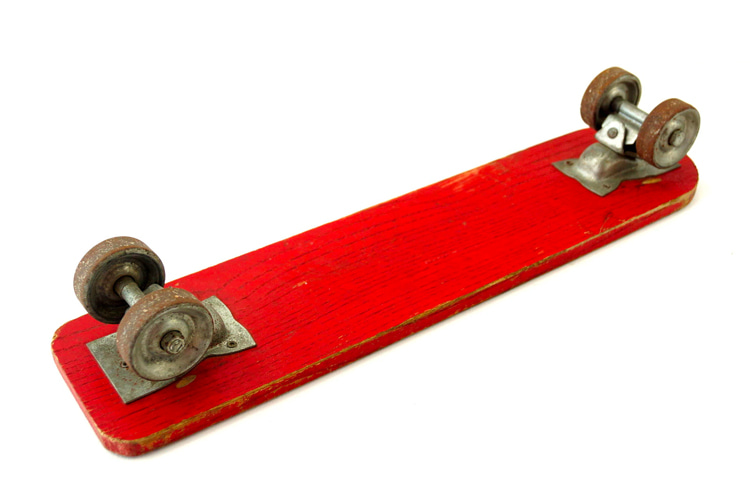
Prehistory | ∞ - 1959
Kids have always had an affinity for their own set of wheels.
The bicycle is the prime example, but bikes were out of reach financially for many families for a long time.
The alternatives were wagons, scooters, and roller skates.
When these store-bought vehicles didn't do the trick, young people resorted to creating their own conveyances.
Some built go-karts or soapbox carts; others made what would end up being the early form of the skateboard.
This first type of skateboard, which dates back to the early 1900s, was actually more like a scooter.
It featured roller skate wheels attached to a two-by-four. Often, the board had a milk crate nailed to it with handles sticking out for control.
Over the next five decades, kids changed the look of these contraptions, taking off the crate and cruising on just the two-by-fours with steel wheels.
Tens of thousands of rollerskates were dismantled and joyfully hammered onto planks of wood.
After World War II, North America experienced a booming economy and an expanding population.
The baby boomers quickly made their presence felt in the marketplace.
The 1950s would see toy manufacturers stumbling over themselves to come up with the next fad to capture the imaginations and piggy banks of kids everywhere.
The appearance of television would help them along. Yo-yos, hula hoops, and the like would rise and fall in favor of the playground.
It was only a matter of time before someone picked up on the potential lying in those roller skate wheels attached to hunks of wood.
The first commercial skateboards hit the marketplace in 1959.
The dawn of the commercial skateboard industry brought new and exciting technological advances, like clay wheels that made the ride smoother and new tricks possible.
But it also signaled an end to a time when kids gleefully, messily, and ingeniously devised their own playthings.
A few old-school riders out here remember skateboarding in the 1960s.
Avid, new-generation teenage skateboarders who do ollies and aerials with their boards believe the sport came into existence in California.
However, some remember skateboarding on Oahu, Hawaii, the day President Kennedy was killed; the radio was on reporting it while they attached a board to a pair of roller skate wheels.
Yes, it was kind of crude, but they rolled down the hills at high speeds with the wheels nailed onto a small plank and made the best of what they had.
There were no fancy graphic decks with high-dollar wheels and trucks then; the island kids knew how to make a skateboard before the California dudes.
Some learned how to make a skateboard from youngsters who could also make woven baskets from palm fronds.
The ingenuity of children back in those days was marvelous.
Nowadays, it's "Mom, I need $140 for a new skateboard; my deck is all chipped up, and the wheels and trucks are shot."
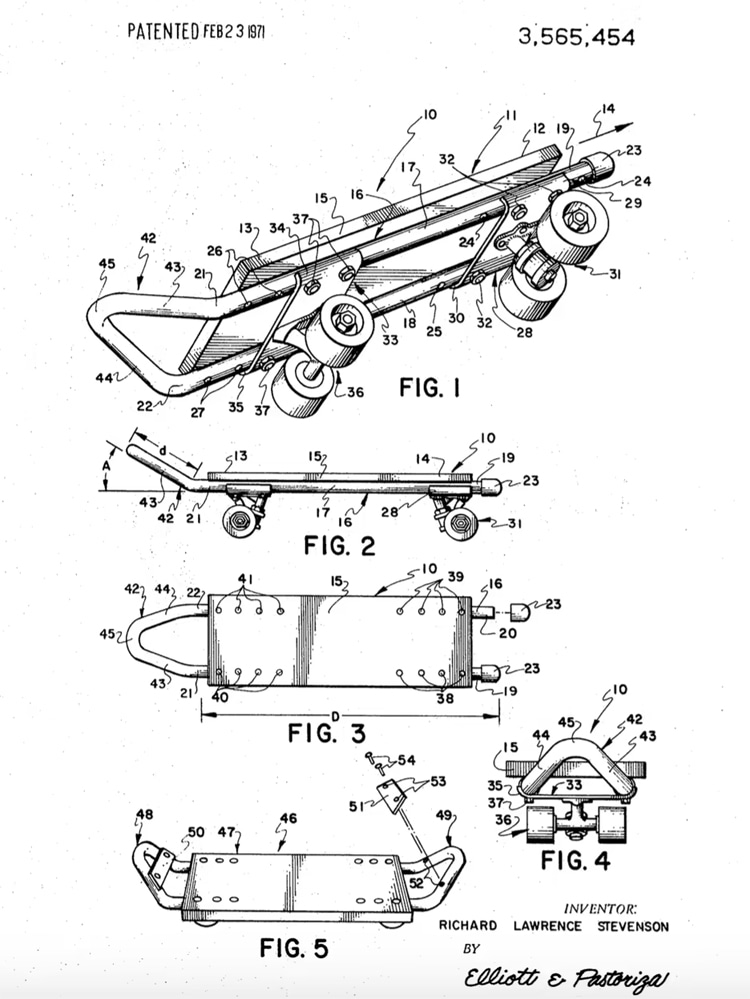
The First Wave | 1959-1965
The late 1950s saw growing commercial interest in the skateboard concept, and by 1959, the first Roller Derby Skateboard had appeared on store shelves.
The introduction of commercially-produced skateboards coincided with the era of the surfer, and people began to tie riding the waves with cruising on a board on land.
By the time the 1960s rolled around, skateboarding had gained a sizable following among the surf crowd.
But when Larry Stevenson, publisher of Surf Guide, began to promote skateboarding, things really started to take off.
Larry's company, Makaha, designed the first professional skateboards in 1963, and a team was formed to promote the product.
Traveling skateboard teams sponsored by skateboard makers would become a staple of skateboard marketing and play a significant role in bringing skateboarding to the world.
Makaha also sponsored the first skateboard contest, which was held in 1963 in Hermosa, California.
Formal skateboard competitions raised the standards of skateboard performance and gave it its sports status.
More skateboard manufacturers appeared on the scene.
By 1965, international contests, movies ("Skaterdater"), a magazine (The Quarterly Skateboarder), and cross-country trips by teams of skateboarders had elevated the sport to enormous heights of popularity.
Over 50 million boards were sold within three years. Then, suddenly, skateboarding died in the fall of 1965.
The first skateboarding crash was due to inferior products, too much inventory, and a public upset by reckless riding.
The manufacturers were so busy making boards that little had been done in the way of research and development.
Beyond replacing the squeaky steel roller skate wheels with smoother-riding clay wheels and refining the trucks (the devices that hold the wheels), there were few technological advances.
Some companies did develop better-quality wheels, but clay wheels were the cheapest to manufacture.
However, clay wheels did not grip the road well, and skaters everywhere were having some nasty falls.
Cities started to ban skateboards in response to health and safety concerns, and after a few fatal accidents, skateboarding was officially drummed out of existence.
Manufacturers lost huge amounts of money due to canceled orders for the Christmas season, and skateboarding virtually disappeared from public view.
But a few genuinely dedicated skaters would keep the sport alive on life support.
The Second Wave | 1973-1980
The late 1960s seem to have been a less innocent time than the early years of that decade.
Legal problems and a lack of innovation in skateboard design were the main factors in the downturn in the popularity of skateboarding that occurred in that period.
But it was also a time of great political and social strife worldwide, and carefree activities like sidewalk surfing were eclipsed in the public's imagination by protests, assassinations, and increasingly controversial war.
Skateboarding didn't disappear entirely, but it certainly entered a dormant phase until a technological breakthrough would bring it back to the forefront.
In 1970, a surfer by the name of Frank Nasworthy began developing a skateboard wheel made from urethane.
The resulting ride was magnificent compared to clay wheels, and by 1973 Nasworthy's Cadillac Wheels had launched skateboarding's second wave.
Truck manufacturers like Independent, Bennett, and Tracker began making trucks specifically designed for skateboarding.
Board manufacturers sprang up overnight, and suddenly the industry was awash with new products and new ideas.
In 1975, Road Rider came out with the first precision-bearing wheel, ending years of loose ball bearings that had a habit of spilling out.
Millions of enthusiasts practiced slalom, downhill, and freestyle skateboarding.
SkateBoarder magazine was resurrected and was soon joined by other publications hoping to cash in on skateboarding's comeback.
Bruce Logan, Russ Howell, Stacy Peralta, Tom Sims, and Gregg Weaver were featured heavily in these magazines.
The sport was on a roll once again.
The first modern outdoor skateboard park was built in Florida in 1976 and was soon followed by hundreds of other parks all over North America.
With all the new possibilities the skateparks offered, skateboarding moved from horizontal to vertical, and slalom and freestyle skateboarding gradually became less popular.
The width of skateboards also changed from six to seven inches to over nine inches.
This increase in size ensured better stability on vertical surfaces.
Top riders of the second wave included Tony Alva, Jay Adams, and Tom "Wally" Inouye.
Wes Humpston marketed the first successful line of boards with graphics under the Dogtown label. Soon, dozens of board manufacturers were putting graphics under their boards.
Pool skating was hugely popular, and as a result of better technology, skaters were able to perform aerials and go well beyond the coping.
In the late 1970s, Alan Gelfand invented the ollie or no-hands aerial and moved skateboarding to the next level.
The roots of street style developed when skaters started to take vertical moves to flatland. Then, skateboarding culture began to mesh with punk and new wave music.
Images of skulls began to appear on skateboards, thanks to the creative genius of Vernon Courtland Johnson at Powell Corporation.
But skating's old nemesis, safety concerns, arose once more.
Insurance became so that many park owners closed their doors, and the bulldozers were brought in.
By the end of 1980, skateboarding had another death, and once again, many were faced with tremendous losses.
As BMX biking became popular and SkateBoarder magazine turned into Action Now, many skaters deserted the sport.
Skateboarding moved underground once more.
But even as the skateparks disappeared, a hardcore contingent built their backyard halfpipes and ramps and continued to develop the sport.
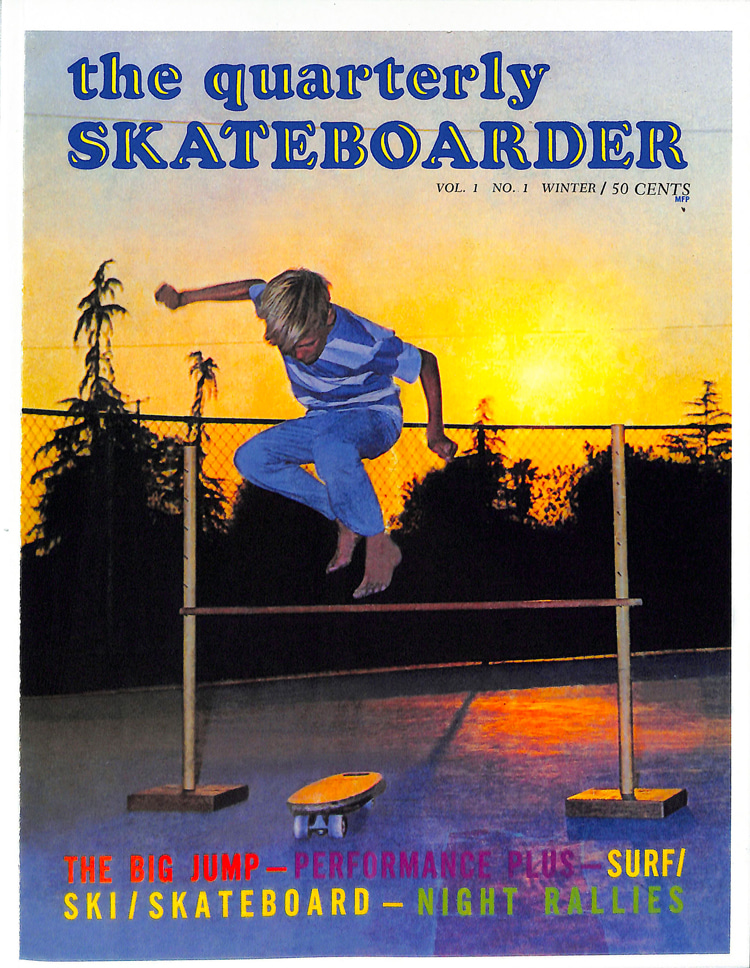
The Third Wave | 1983-1991
More legal wrangling and competition from other youth pursuits like BMX biking led to a second fallow period for skateboarding in the early 1980s.
Although skate contests were held, the turnout was small, and the prize money was even smaller.
But, as in the past, a core of dedicated skaters kept the sport alive.
In 1981, Thrasher magazine began publication in an effort to provide hardcore skaters with information on the skateboard scene.
By 1983, skate manufacturers were beginning to see the sport on the upswing, and Transworld Skateboarding magazine entered the skate scene.
Vert riding took off in 1984, followed closely by street-style skating. Launch ramps became popular.
Powell Peralta created "The Bones Brigade Video Show," which helped propel skateboarding to new levels of popularity.
Numerous vertical champions emerged, including Christian Hosoi, Lance Mountain, Neil Blender, and Tony Hawk.
On the streets, Mark Gonzales, Natas Kaupas, and Tommy Guerrero created new ollie variations.
Freestyle skateboarding was also a part of the scene, and Rodney Mullen dominated all contests.
Board royalties and contest winnings escalated, and some professional skaters pulled down earnings of $10,000 a month.
The National Skateboard Association, headed by Frank Hawk, held numerous contests across North America and eventually throughout the world.
Dozens of new manufacturers sprung up, but in the mid to late 1980s, three handled most of the skate market - Powell Peralta, Vision/Sims, and Santa Cruz.
Skateboard shoes from Airwalk, Vans, and Vision became hugely popular, along with skate fashion, even among non-skaters.
Toward the end of the decade, the focus shifted to street skating, and vert riding became less popular.
Several pro skaters decided to leave the larger manufacturers and start their own skateboard companies.
One of the first to do this was Steve Rocco, who started up World Industries.
New school skateboarding was born. Its focus was on ollies and technical tricks, and it took on a whole new attitude.
By 1991, a worldwide recession hit, and the skate industry was deeply affected. As in the past, many manufacturers faced significant financial losses.
The industry turned extremely negative and began the process of reinventing itself.
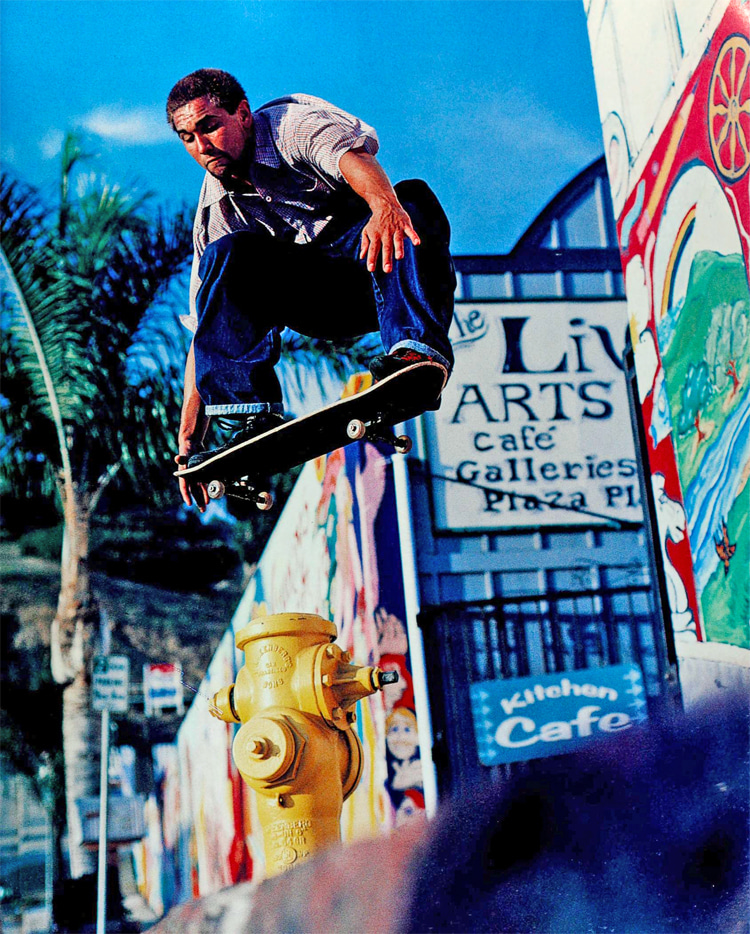
The Fourth Wave | 1993-
The economic recession put a damper on all industries in the early 1990s. Skateboarding also had to contend with a new nemesis - rollerblading.
As in the past, a hardcore contingent remained with the sport, but this time the attrition was not as great as in the past.
The growth of cable television, satellite TV, and the internet would lead to greater worldwide awareness of skateboarding.
The "baby boomlet" - the offspring of the baby boomers - were hitting their rebellious teens.
This fact, combined with their significant spending power, led to skateboarding's fourth and possibly permanent wave.
Those kids who took up skating in the 1970s now have kids of their own, to whom they want to pass on the fun and liberation of skateboarding.
And many of those young moms and dads are digging out their old boards and hitting the pavement once more themselves.
By the mid-1990s, skateboarding reemerged again, and the fourth wave had begun.
In 1995, skateboarding gained a great deal of exposure at the ESPN 2 Extreme Games.
Skateboard shoe manufacturers like Etnies and Vans began selling huge quantities of products and were joined by other soft goods manufacturers eager to cash in on skateboarding's popularity once again.
At the end of the 1990s, skateboarding's focus remained street style, and the industry was filled with numerous manufacturers and marketers.
In many cases, pro riders develop their products and manage their own companies.
Longboarding, a once forgotten art featuring large boards, has begun to make a comeback, and downhill skateboarding has entered a whole new dimension thanks to street luge.
Public skateboard parks began to be built once again in California, thanks to legislation changes.
The hard work of Jim Fitzpatrick and the International Association of Skateboard Companies (IASC) has ensured that other states will follow, and more parks are scheduled for construction over the following years.
Over the past decades, skateboarding has had its peaks and valleys in popularity.
Poor product, safety issues, and economic recessions have all contributed to the valleys.
However, skateboard technology has vastly improved since clay wheels.
Regarding injuries, the sport remains much safer than football, rollerblading, or hockey (when you look at the percentage of participants injured).
Despite safety concerns or economic recessions, the sport endures because it is fun.
Words by Michael Brooke | Author of "The Concrete Wave: The History of Skateboarding"
